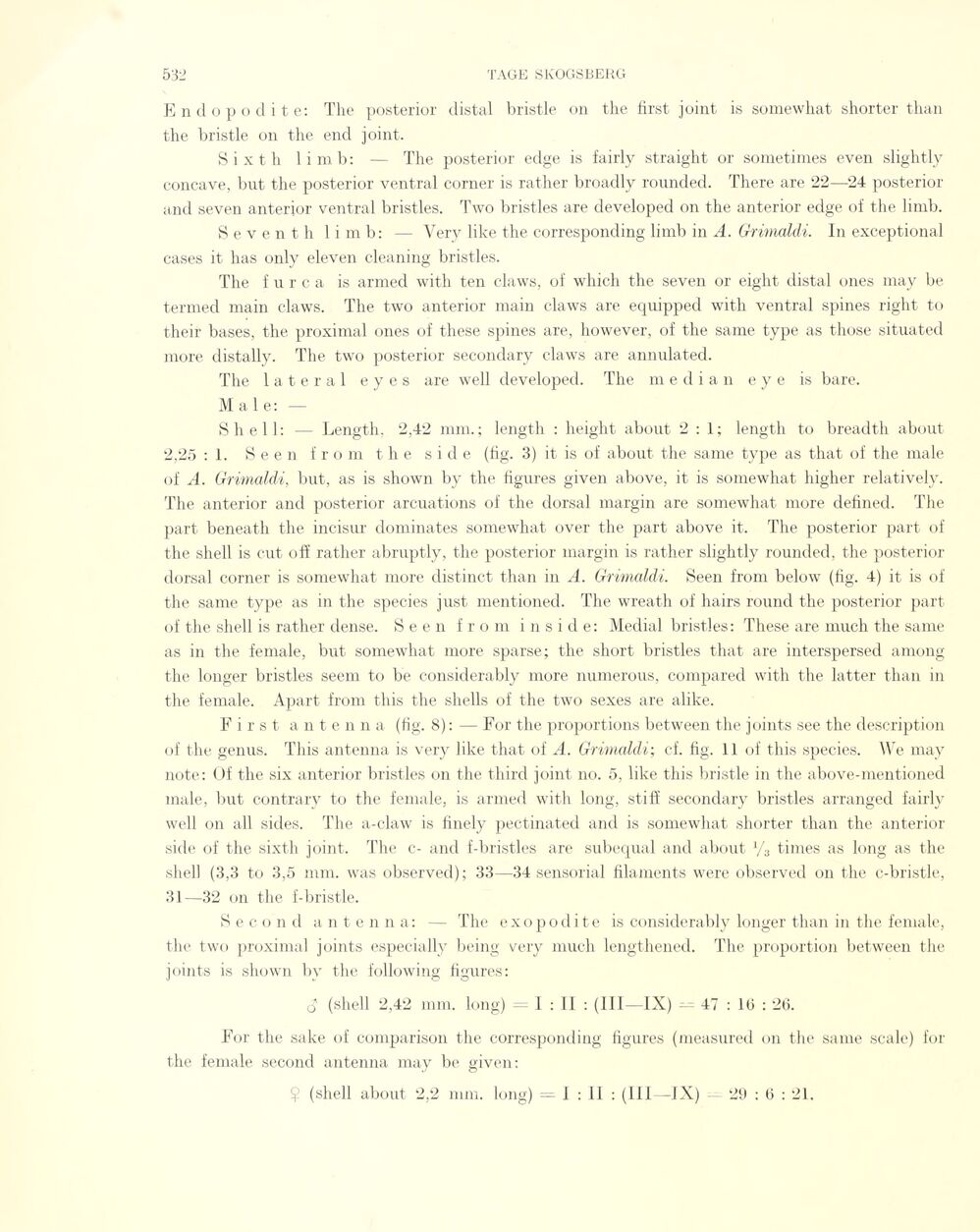
Full resolution (JPEG) - On this page / på denna sida - Sidor ...

<< prev. page << föreg. sida << >> nästa sida >> next page >>
Below is the raw OCR text
from the above scanned image.
Do you see an error? Proofread the page now!
Här nedan syns maskintolkade texten från faksimilbilden ovan.
Ser du något fel? Korrekturläs sidan nu!
This page has never been proofread. / Denna sida har aldrig korrekturlästs.
End opod ite: The posterior distal bristle on the first joint is somewkat shorter than
the bristle on the end joint.
Sixth li mb: — The posterior edge is fairly straight or sometimes even slightly
concave, but the posterior ventral corner is rather broadly rounded. There are 22—24 posterior
and seven anterior ventral bristles. Two bristles are developed on the anterior edge of the limb.
S e v e n t h limb: — Very like the corresponding limb in A. Grimaldi. In exceptional
cases it has only eleven cleaning bristles.
The furca is armed with ten claws, of which the seven or eight distal ones may be
termed main claws. The two anterior main claws are equipped with ventral spines right to
their bases, the proximal ones of these spines are, however, of the same type as those situated
more distally. The two posterior secondary claws are annulated.
The lateral eyes are well developed. The median eye is bare.
Male: —
Shell: — Length, 2,42 mm. ; length : height about 2:1; length to breadth about
2,25 : 1. Seen from the side (hg. 3) it is of about the same type as that of the male
of A. Grimaldi, but, as is shown by the figures given above, it is somewhat higher relatively.
The anterior and posterior arcuations of the dorsal margin are somewhat more defined. The
part beneath the incisur dominâtes somewhat over the part above it. The posterior part of
the shell is cut off rather abruptly, the posterior margin is rather slightly rounded, the posterior
dorsal corner is somewhat more distinct than in A. Grimaldi. Seen from below (fig. 4) it is of
the same type as in the species just mentioned. The wreath of hairs round the posterior part
of the shell is rather dense. Seen from inside: Medial bristles: These are much the same
as in the female, but somewhat more sparse; the short bristles that are interspersed among
the longer bristles seem to be considerably more numerous, compared with the latter than in
the female. Apart from this the shells of the two sexes are alike.
First antenna (fig. 8): — For the proportions between the joints see the description
of the genus. This antenna is very like that of A. Grimaldi-, cf. fig. 11 of this species. We may
note: Of the six anterior bristles on the third joint no. 5, like this bristle in the above-mentioned
male, but contrary to the female, is armed with long, stiff secondary bristles arranged fairly
well on all sides. The a-claw is finely pectinated and is somewhat shorter than the anterior
side of the sixth joint. The c- and f-bristles are subequal and about 1/3 times as long as the
shell (3,3 to 3,5 mm. was observed); 33—34 sensorial filaments were observed on the c-bristle,
31—32 on the f-bristle.
Second antenna: — The exopodite is considerably longer than in the female,
the two proximal joints especially being very much lengthened. The proportion between the
joints is shown by the following figures:
o (shell 2,42 mm. long) - I : II : (III—IX) - 47 : 10 : 26.
For the sake of comparison the corresponding figures (measured on the same scale) for
the female second antenna may be given:
Ç (shell about 2,2 mm. long) — I : II : (III—IX) — 29 : 0 : 21.
<< prev. page << föreg. sida << >> nästa sida >> next page >>